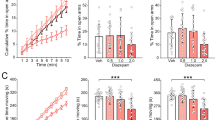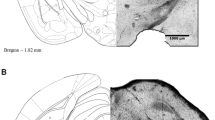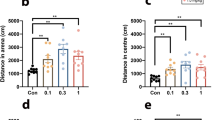Abstract
The literature on the effects of CCK receptor manipulations in animal models of anxiety is rife with inconsistency, and the data subject to a variety of methodological and interpretative difficulties. In the present paper, the effects of a range of CCK receptor ligands on anxiety in male mice have been assessed using an ethological version of the elevated plusmaze test. Compounds selected for study were the agonists, CCK-4 and CCK-8s (12.5–100µg/kg), and the antagonists, devazepide, L-365, 260 and PD 135158 (1.0 µg/kg–1.0mg/kg). CCK-4 failed to produce any significant behavioural effects over the dose range tested, while treatment with the sulphated octapeptide, CCK-8s, induced signs of behavioural inhibition at 100 µ/kg without altering anxiety-related indices. Furthermore, in contrast to the clear anxiolytic profile of diazepam (1 mg/kg), and despite the comprehensive behavioural profiles yielded by ethological analysis, all three CCK receptor antagonists studied (devazepide, L-365, 260 and PD 135158) were found to be without significant effect under present test conditions. Together, present findings provide little support for the involvement of CCK receptor mechanisms in anxiety and, in particular, the form of anxiety evoked in mice by exposure to a plus-maze.
Similar content being viewed by others
References
Abelson JL, Nesse RM (1994) Pentagastrin infusions in patients with panic disorder. 1.Symptoms and cardiovascular responses. Biol Psychiatry 36:73–83
Adamec RE, Shallow T (1993) Lasting effects on rodent anxiety of a single exposure to a cat. Physiol Behav 54:101–109
Bickerdike MJ, Marsden CA, Dourish CT, Fletcher A (1994) The influence of 5-hydroxytryptamine reuptake blockade on CCK receptor antagonist effects in the rat elevated zero-maze. Eur J Pharmacol 271:403–411
Bradwejn J, Koszycki D, Meterissian G (1990) Cholecystokinintetrapeptide induces panic attacks in patients with panic disorder. Can J Psychiatry 35:83–85
Bradwejn J, Koszycki D, Shriqui C (1991) Enhanced sensitivity to cholecystokinin tetrapeptide in panic disorder — clinical and behavioral findings. Arch Gen Psychiatry 48:603–610
Bradwejn J, Koszycki D, Couetoux du Tertre A, Bourin M, Palmour RM, Ervin FR (1992) The cholecystokinin hypothesis of panic and anxiety disorders: a review. J Psychopharmacol 6:345–351
Bradwejn J, Koszycki D, Dutertre AC Vanmegen H, Denboer J, Westenberg H, Annable L (1994) The panicogenic effects of cholecystokinin-tetrapeptide are antagonized by L-365,260, a central cholecystokinin receptor antagonist, in patients with panic disorder. Arch Gen Psychiatry 51:486–493
Chopin P, Briley M (1993) The benzodiazepine antagonist flumazenil blocks the effects of CCK receptor agonists and antagonists in the elevated plus-maze. Psychopharmacology 110:409–414
Cole JC, Rodgers RJ (1993) An ethological analysis of the effects of chlordiazepoxide and bretazenil (Ro 16-6028) in the murine elevated plus-maze. Behav Pharmacol 4:573–580
Cole JC, Rodgers RJ (1994) Ethological evaluation of the effects of acute and chronic buspirone treatment in the murine elevated plus-maze test — comparison with haloperidol. Psychopharmacology 114:288–296
Cole JC, Rodgers RJ (1995) Ethological comparison of the effects of diazepam and acute/chronic imipramine on the behaviour of mice in the elevated plus-maze. Pharmacol Biochem Behav 52:473–478
Cole, JC, Burroughs, GJ, Laverty, CR, Sherriff, NC, Sparham, EA, Rodgers RJ (1995) Anxiolytic-like effects of yohimbine in the murine plus-maze: strain independence and evidence against α2-adrenoceptor mediation. Psychopharmacology 118:425–436
Costall B, Domeney AM, Hughes J, Kelly ME, Naylor RJ, Woodruff GN (1991) Anxiolytic effects of CCK-B antagonists. Neuropeptides 19:65–73
Crawley JN, Corwin RL (1994) Biological actions of cholecystokinin. Peptides 15:731–755
Cutler NR, Sramek JJ, Kramer MS, Reines SA (1994) Placebo-controlled study of a CCKB antagonist in patents with panic disorder. Biol Psychiatry 35:680
Dauge V, Derrien M, Durieux C, Noble F, Corringer PJ, Roques BP (1992) Effects of selective agonists for cholecystokinin receptors CCK-B in nociception and behavior in rodents. Therapie 47:531–539
Dawson GR, Rupniak NMJ, Iversen SD, Tricklebank MD (1994) Lack of effect of CCKB receptor antagonists in animal screens for anxiolytic drugs. J Psychopharmacol 8:A47
DeMontigny C (1989) Cholecystokinin tetrapeptide induces panic-like attacks in healthy-volunteers — preliminary findings. Arch Gen Psychiatry 46:511–517
Derrien M, Durieux C, Dauge V, Roques BP (1993) Involvement of D(2) dopaminergic receptors in the emotional and motivational responses induced by injection of CCK-8 in the posterior part of the rat nucleus-accumbens. Brain Res 617:181–188
Derrien M, McCort-Tranchepain I, Ducos B, Roques BP, Durieux C (1994) Heterogeneity of CCK-B receptors involved in animal-models of anxiety. Pharmacol Biochem Behav 49:133–141
Dourish CT, Bickerdike MJ, Stanhope KJ, Fletcher A, Marsden CT (1994) Profile of CCKA and CCKB receptor antagonists in the CER end elevated plus-maze models of anxiety in the rat: modulation by 5-HT reuptake blockade. Behav Pharmacol 5:29–30
Ervin FR, Palmour RM, Bradwejn J (1991) A new primate model for panic disorder. Biol Psychiatry 29:430S
Fink H, Rex A, Marsden CA (1994) Behavioural and neurochemical effects of CCK-fragments in animal models of anxiety. Behav Pharmacol 5:30
Harro J, Vasar E (1991a) Cholecystokinin-induced anxiety — how is it reflected in studies on exploratory-behavior? Neurosci Biobehav Rev 15:473–477
Harro J, Vasar E (1991b) Evidence that CCKB receptors mediate the regulation of exploratory behavior in the rat. Eur J Pharmacol 193:379–381
Harro J, Pold M, Vasar E (1990) Anxiogenic-like action of cerulein, a CCK-8 receptor agonist, in the mouse-influence of acute and subchronic diazepam treatment. Naunyn-Schmiedeberg's Arch Pharmacol 341:62–67
Harro J, Vasar E, Bradwejn J (1993) CCK in animal and human research on anxiety. Trends Pharmacol Sci 14:244–249
Hays SE, Beinfeld MC, Jensen RT, Goodwin FK, Paul SM (1980) Demonstration of a putative receptor site for cholecystokinin in the rat brain. Neuropeptides 1:53–62
Hendrie CA, Dourish CT (1993) Effects of cholecystokinin tetrapeptide (CCK-4) and the CCKB antagonist LY-288513 in a putative model of panic in the mouse. Br J Pharmacol 108:26P
Hendrie CA, Neill JC (1992) Ethological analysis of the role of CCK in anxiety. In: Dourish CT, Cooper SJ, Iversen SD, Iversen LL (eds) Multiple cholecystokinin receptors in the CNS. Oxford University Press, Oxford, pp 132–142
Hughes J, Boden P, Costall B et al. (1990) Development of a class of selective cholecystokinin type-B receptor antagonists having potent anxiolytic activity. Proc Natl Acad Sci USA 87:6728–6732
Innis RB, Snyder SH (1980) Cholecystokinin receptor binding in brain and pacreas: regulation of pancreatic binding by cyclic and acyclic guanine nucleotides. Eur J Pharmacol 65:123–124
Ivy AC, Goldberg EA (1928) A hormone mechanism for gall bladder contraction and evacuation. Am J Physiol 86:599–613
Jensen RT, Lemp GF, Gardner JD (1980) Interaction of cholecystokinin with specific membrane receptors on pancreatic acinae cells. Proc Natl Acad Sci USA 77:2079–2083
Jorpes JE, Mutt V (1966) Cholecystokinin and pancreozymin, one single hormone? Acta Physiol Scand 66:196–202
Lines C, traub M, Ambrose J (1993) CCK and anxiety in normal volunteers. Neuropsychopharmacology 9:S 181–182
Lister RG (1987) The use of a plus-maze to measure anxiety in the mouse. Psychopharmacology 92:180–185
Mannisto PT, Lang A, Harro J, Peuranen E, Bradwejn J, Vasar E (1994) Opposite effects mediated by CCKA and CCKB receptors in behavioral and hormonal studies in rats. Naunyn-Schmiedeberg's Arch Pharmacol 349:478–484
Moran TH, Robinson PH, Goldrich MS, Mchugh PR (1986) 2 brain cholecystokinin receptors — implications for behavioral actions. Brain Res 362:175–179
Newman JD, Crepeau LJ (1991) Heart rate changes following administration of putative panicogenic chemicals in squirrel monkeys. Soc Neurosci Abstr 17:420.13
Pavlasevic S, Bednar I, Qureshi GA, Sodersten P (1993) Brain cholecystokinin tetrapeptide levels are increased in a rat model of anxiety. Neuroreport 5:225–228
Pellow S, Chopin P, File SE, Briley M (1985) Validation of openclosed arm entries in an elevated plus-maze as a measure of anxiety in the rat. J Neurosci Methods 14:149–169
Rataud J, Darche F, Piot O, Stutzmann JM, Bohme GA, Blanchard JC (1991) Anxiolytic effect of CCK-Antagonists on plus-maze behavior in mice. Brain Res 548:315–317
Ravard S, Dourish CT (1990) Cholecystokinin and anxiety. Trends Pharmacol Sci 11:271–273
Ravard S, Dourish CT, Iversen SD (1990) Evidence that the anxiolytic-like effects of the CCK antagonists devazepide and L-365, 260 in the elevated plus-maze paradigm in rats are mediated by CCK receptors. Br J Pharmacol 101:576P
Rehfeld JF (1992) CCK and anxiety: introduction. In: Dourish CT, Cooper SJ, Iversen SD, Iversen LL (eds) Multiple cholecystokinin receptors in the CNS. Oxford University Press, Oxford, pp 117–120
Rex A, Barth T, Voigt JP, Domeney AM, Fink H (1994a) Effects of cholecystokinin tetrapeptide and sulfated cholecystokinin-octapeptide in rat models of anxiety. Neurosci Lett 172:139–142
Rex A, Fink H, Marsden CA (1994b) Effects of BOC-CCK-4 and L365, 260 on cortical 5-HT release in guinea-pigs on exposure to the elevated plus-maze. Neuropharmacology 33:559–565
Rodgers RJ, Cole JC (1993) Anxitey enhancement in the murine elevated plus-maze by immediate prior exposure to social stressors. Physiol Behav 53:83–388
Rodgers RJ, Cole JC (1994a) The elevated plus-maze: pharmacology, methodology and ethology. In: Cooper SJ, Hendrie CA (eds) Ethology and Psychopharmacology. Wiley, Chichester, pp 9–44
Rodgers RJ, Cole JC (1994b) Anxiolytic-like effect of (s)-WAY-100135, a 5-HT1A receptor antagonist, in the murine elevated plus-maze test. Eur J Pharmacol 261:321–325
Rodgers RJ, Johnson NJT (1995a) Cholecystokinin and anxiety: promises and pitfalls. Crit Rev Neurobio (in press)
Rodgers RJ, Johnson NJT (1995b) Factor analysis of the spatiotemporal and ethological measures in the murine elevated plus-maze. Pharmacol Biochem Behav 52:297–303
Rodgers RJ, Shepherd JK (1993) Influence of prior maze experience on behaviour and response to diazepam in the elevated plus-maze and light/dark tests of anxiety in mice. Psychopharmacology 113:237–242
Rodgers RJ, Cole JC, Cobain MR, Daly P, Doran PJ, Eells JR, Wallis P (1992a) Anxiogenic-like effects of fluprazine and eltoprazine in the mouse elevated plus-maze — profile comparisons with 8-OH-DPAT, CGS 12066B, TFMPP and mCPP. Behav Pharmacol 3:621–634
Rodgers RJ, Lee C, Shepherd JK (1992b) Effects of diazepam on behavioural and antinociceptive responses to the elevated plusmaze in male mice depend upon treatment regimen and prior maze experience. Psychopharmacology 106:102–110
Rodgers RJ, Cole JC, Davies A (1994a) Antianxiety and behavioral suppressant actions of the novel 5-HT1A receptor agonist, flesinoxan. Pharmacol Biochem Behav 48:959–963
Rodgers RJ, Nikulina EM, Cole JC (1994b) Dopamine D-1 and D-2 receptor ligands modulate the behavior of mice in the elevated plus-maze. Pharmacol Biochem Behav 49:985–995
Rodgers RJ, Cole JC, Aboualfa K, Stephenson LH (1995) Ethopharmacological analysis of the effects of putative “anxiogenic” agents in the mouse elevated plus-maze. Pharmacol Biochem Behav 52 (in press)
Rupniak NMJ, Schaffer L, Siegl P, Iversen SD (1993) Failure of intravenous pentagastrin challenge to induce panic-like effects in rhesus-monkeys. Neuropeptides 25:115–119
Saito A, Goldfine ID, Williams JA (1980) Characterization of receptors for cholecystokinin and related peptides in mouse cerebral cortex. J Neurochem 37:433–490
Sauter A, Frick W (1983) Determination of cholecystokinin tetrapeptide and cholecystokinin octapeptide sulfate in different rat-brain regions by high-pressure liquid-chromatography with electrochemical detection. Anal Biochem 133:307–313
Shepherd JK, Grewal SS, Fletcher A, Bill DJ, Dourish CT (1994) Behavioral and pharmacological characterization of the elevated zero-maze as an animal-model of anxiety. Psychopharmacology 116:56–64
Singh L, Field MJ, Hughes J, Menzies R, Oles RJ, Vass CA, Woodruff GN (1991a) The behavioral properties of CI-988, a selective cholecystokinin(B) receptor antagonist. Br J Pharmacol 104:239–245
Singh L, Lewis AS, Field MJ, Hughes J, Woodruff GN (1991b) Evidence for an involvement of the brain cholecystokinin-B receptor in anxiety. Proc Natl Acad Sci USA 88:1130–1133
Treit D, Menard J, Royan C (1993) Anxiogenic stimuli in the elevated plus-maze. Pharmacol Biochem Behav 44:463–469
Vanderhaegen JJ, Signeau JC, Gepts W (1975) New peptide in the vertebrate CNS reacting with antigastrin antibodies. Nature 257:604–605
Van Megen HJGM, Westenberg HGM, Denboer JA, Haigh JRM, Traub M (1994) Pentagastrin induced panic attacks — enhanced sensitivity in panic disorder patients. Psychopharmacology 114:449–455
Vasar E, Peuranen E, Harro J, Lang A, Oreland L, Mannisto PT (1993a) Social-isolation of rats increases the density of cholecystokinin receptors in the frontal-cortex and abolishes the antiexploratory effect of cerulein. Naunyn-Schmiedeberg's Arch Pharmacol 348:96–101
Vasar E, Peuranen E, Oopik T, Harro J, Mannisto PT (1993b) Ondansetron, an antagonist of 5-HT3-receptors, antagonizes the antiexploratory effect of cerulein, an agonist of CCK-receptors, in the elevated plus-maze. Psychopharmacology 110:213–218
Vasar E, Lang A, Harro J, Bourin M, Bradwejn J (1994) Evidence for potentiation by CCK antagonists of the effect of cholecystokinin-octapeptide in the elevated plus-maze. Neuropharmacology 33:729–735
Author information
Authors and Affiliations
Rights and permissions
About this article
Cite this article
Johnson, N.J.T., Rodgers, R.J. Ethological analysis of cholecystokinin (CCKA and CCKB) receptor ligands in the elevated plus-maze test of anxiety in mice. Psychopharmacology 124, 355–364 (1996). https://doi.org/10.1007/BF02247441
Received:
Revised:
Issue Date:
DOI: https://doi.org/10.1007/BF02247441




